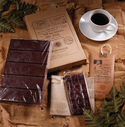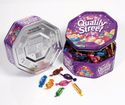Sweeter when greener
20 May 2009Brand owners are involving packaging manufacturers to help make the confectionery sector greener and sweeter. Joanne Hunter reports
Confectionery is one of life’s small luxuries. For some people the tinge of guilt that goes with munching on chocolate and sucking sweets adds to the pleasure. For “conscious consumers” and industries with commercially important sustainability agendas, indulgence and wasteful behaviour can stir up another level of guilt. But it just might be possible to avoid the extra burden on the conscience if packaging is designed to be less of a burden on the environment, on society and on the supply chain itself.
Recently, the founder of a well known organic chocolate brand was heard to say: “Ethics is our gift with purchase”. A packaging company that applies high standards to procuring raw materials, operates by clean, green methods, considers packaging design “in the round” from performance to end-of-life, could call sustainability its “gift with purchase”, don’t you think?
Easter eggs this season were lucrative for the chocolate makers and along the supply chain additional savings were made in raw materials, transport and environmental damage. Thanks to a testing UK manufacturers’ Easter egg challenge, the weight of packaging plummeted and multiple layers of protection were shed – notably without too many eggs coming to harm. Perhaps the exercise has taught confectioners lessons they might apply to packaging of sweets sold year-round, to achieve further savings in raw material, CO2 emissions and embedded carbon.
Confectionery suppliers are encouraged to continue to commit to future waste reductions across the supply chain, says WRAP (Waste Resources Action Programme), the government backed waste reduction initiative. Andy Dawe, head of retail programmes at WRAP, says: “Confectioners have made great achievements this year on Easter egg packaging and we hope they will continue to build on this good work across the supply chain looking at all packaging, and reducing food waste.”
Without detracting from our enjoyment of buying, giving and eating Easter eggs this year, retailers and manufacturers alleviated the environmental burden of packaging in different ways. Cadbury UK claims unboxed Eco eggs improved the product to pack ratio from below 20 per cent to above 90 per cent. Cadbury’s, Nestlé and Marks & Spencer stripped out many tonnes of plastics and cartonboard. M&S ensured more than 85 per cent of total packaging was recyclable and Mars focused on its use of 100 per cent recycled board. Nestlé highlights that because eggs were more compact, it saved 48,000 road miles in transportation.
In comparison to the annual “egg fest”, the problem of environmental damage by the packaging of everyday confectionery is much smaller and can be easily fixed, according to the UK’s Industry Council for Packaging and the Environment. Incpen has studied the packaging by weight of 73 product groups, and found packaging that was perceived to be excessive came to just over 2 per cent of total sales. Confectionery packaging featured very low on the list of culprits, by weight.
However, while great on-shelf, its high visibility is also its downfall. Munching on the move creates a potential litter problem. Incpen therefore stresses the importance of a prominent “tidy man” logo on packaging as a reminder to dispose of wrappers thoughtfully.
Incpen director Jane Bickerstaffe says that in these tough economic times we may comfort ourselves by buying still more chocolate. So even if Britain isn’t booming, it can still be kept tidy.
The packaging of premium brands has to be as tasty as the contents and offer a sensory experience. At the same time, the brand owners have to consider their reputations as ethically run companies. It’s a balancing act.
Duchy Originals introduced its Chocolate Bezants in a folding box design to substitute an existing product in a box with a lid. In doing so it reduced the weight of the packaging by 48 per cent. The board was certified by the Forestry Stewardship Council (FSC), which ensured the raw materials came from sustainable timber supplies.
Chocolate maker Green & Black’s is focused on the ethical sourcing of organic raw materials and spent nearly three years on work to shed 61 per cent of packaging weight from Easter eggs. One ploy was to make the shells thicker: more indulgent as well as robust.
But, avoiding environmental impact is not just for Easter – the company’s gift range re-launching “September time” will express quality and indulgence with strong, vibrant graphics and without superfluous “dressing up”, says brand manager Anita Kinnisburgh. The next move after looking at unit packaging, she says, is to look at transport packaging as a means to reduce the carbon footprint.
Consumers expect responsible behaviour from a brand. As Green & Black’s co-founder Josephine Fairley says: ethics is “our gift with purchase”.
The sustainable “gift” that packaging provides is this: bar wrappers comprise a minimum 70 per cent FSC certified material, 100 per cent recyclable and printed with water-based inks. Cartons use only recycled board – and can be recycled. Wrapping materials are produced using a clean, low energy method – and recyclable. Assortments of chocolates use recyclable FSC board and non-bleached glassine paper for the inner wrap. The European Green Dot logo signifies that the producer has made a contribution towards the recycling of packaging.
A product such as Green & Black’s is a special challenge to packaging suppliers because the brand must maintain the consumer appeal of a premium feel, look and protection for goods, while meeting sustainability goals. In particular, packaging has to be able to retain the intense natural flavours and prevent taint between products.
Green & Black’s supply chain expertise is being shared with Cadbury’s, its owner since 2005, who is also on a journey towards sustainable goals. Cadbury’s Purple Goes Green programme of 2007 set out to reduce carbon emissions by 10 per cent by next year, and “a 50 per cent absolute reduction” by 2020.
Mars has taken reusable packaging to a new level with a plastics container for its Celebrations chocolate assortment, and thereafter for use around the kitchen. Using plastics has reduced the weight by 46 per cent compared with the tin alternative and transport packaging has been switched from corrugated cases to shrinkwrap, to give a further 87 per cent weight reduction.
In 2008 Nestlé reduced the thickness of the metal used in Quality Street tins, saving 214 tonne of tinplate each year. Further reducing tinplate gauge by
0.01 mm for small round tins will result in a 37 tonne annual saving from 2008. A lower height to the large tin will save more than 2,000 tonne.
In another significant ‘green’ move, Nestlé switched Quality Street twistwraps to biodegradable film. The NatureFlex film will break down in a home compost bin or industrial compost environment within a matter of weeks, says manufacturer Innovia. The compost heap is a convenient last resting place for twistwraps and other biodegradable packaging – and it works, confirms Andy Sweetman, global marketing manager for sustainable technologies at Innovia.
Thanks to long experience in conventional films, Innovia successfully cracked problems of barrier and technical capability in Natureflex. It offers inherent deadfold and anti-static properties, high gloss and transparency, resistance to grease and oil, good barrier to gases and aromas, and a wide heat-seal range. Forays into confectionery led by retailers and product manufacturers are widening the scope of biodegradable films beyond fruit and vegetables.
Does the price point make it a sustainable option? Andy Sweetman explains that while the material is currently three times the cost of standard films, the actual on-cost per finished product “is not so great”.
Entire production processes can be made cleaner and greener. For example, a German packaging film manufacturer studied its incomings and outgoings to avoid unnecessary waste and carbon emissions. Alesco also found profitable outlets for production waste through energy reuse and sale of by-product. By rooting out embedded carbon, the producer of PE film products and biodegradable films is able to claim carbon-neutral status for both. A waste cutting campaign runs across the company, covering internal operations and the transport of people and product.
Alesco supports carbon-neutral claims with a ‘climate calculator’, which determines the quantity of CO2 released in the production of standard PP films and costs the compensation required for each order. An emission reduction certificate is then issued, with the proceeds going towards environmental protection across the world. For biodegradable films, the proceeds fund a project to generate electricity with renewable biomass.
Turning waste into secondary raw material, for in-house savings or for sale, is also profitable. The film manufacturer recycles residual dyes and recovers solvent, to cut down use of primary raw materials, disposal requirements and freight emissions. Film re-granulation feeds waste back into production. Heat is captured and reused after post-combustion equipment has cleaned the extracted air of solvent. Dye sludge is sent for use in building material manufacturing.
With help from the packaging industry and enlightened brands, it is possible for consumers to enjoy the guilty pleasure of sugary indulgences and not put an unnecessary burden on the environment.
Askinosie Chocolate and GoodOnYa Bar opt for green touch Askinosie Chocolate and GoodOnYa Bar Duchy Originals Chocolate Bezants in a folding box is loads lighter Duchy Originals Chocolate Bezants Quality Street wrappers turned to Natureflex by Innovia Quality Street So easy to spot the difference between last year's Smarties egg and this year's Smarties eggs





